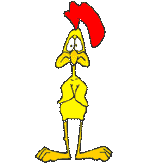
I'm back! I think we should all get used to the fact that blogging every day is just not going to happen for me. This time, I actually have a good reason besides just being lazy. I was out of town, attending a wedding (the first of three this summer, so if you notice a couple more weekends with a conspicuous lack of posting...don't be alarmed).
It was a very enjoyable wedding, filled with love and laughter and plenty of feel-good wedding traditions like the throwing of the bouquet, the bride and groom shoving cake in each others' faces, the adorable flower girl dancing on big people's shoes, and of course, the Hokey Pokey and the Chicken Dance.
Except...did you ever wonder where those two dances came from and why they are an intregal component of a wedding reception? I'm not as worried about the Hokey Pokey's origins; it seems to fall into the "learn the parts of the body" genre of songs for preschoolers, much like Head, Shoulders, Knees and Toes. (Which I might request at Wedding #2 next month - why does the Hokey Pokey get all the wedding love?)
But the Chicken Dance is just plain weird, so I decided to perform some of my famous internet sleuthing to see what I could discover. I first turned to Wikipedia (because duh, where else can you find such a vast resource of reliable information?) So here we go:
The Chicken Dance song was composed in the 1950s by a Swiss accordian player named Werner Thomas. The original song title was actually Der Voglertanz, which means "The Bird Dance." Thomas played it at hotels and restaurants starting in 1963, but the song didn't find international success until a local Dutch band "De Electronica" released it in 1977. Since then, over 140 different versions have been recorded worldwide, for a total of 40 million records. The most popular version, the one we usually hear at weddings, was recorded by the Emeralds and released in 1981.
This is all well and good, but I'm more interested in the dance rather than the song behind it - HOW did this dance get created, and WHY is it so popular at weddings? Wikipedia offers no information about the dance other than a description of the steps. (Side note: I've been doing the third step wrong for 25 years. I always hold my arms bent next to me when I wiggle down to the ground, a la The Twist, but evidently you're supposed to "make a chicken's tail feathers with your arms and hands" instead.)
So I consulted some other website that does not look entirely credible, but at least it features a dancing chicken and some audio of Der Voglertanz for your enjoyment. (Except they claim that Thomas actually called it The Duck Dance, or Der Ententanz. This is turning into a bigger mystery than I anticipated*.) This site offers the vaguest of explanations for the dance's origins: "People spontaneously 'began to move with the melody.' A leg here, an arm up there and suddenly Thomas thought of his animals. The dance evolved to include a beak, wing and tail motions."
This reeks of conspiracy. As Paris Hilton and Vanessa Hudgens will attest to, you can't hide anything - the Internet will find you. But all I get is, the dance just "evolved"?? I want names! Dates! Marketing plans that describe how some sinister individual has not only convinced millions to flap their arms like a chicken at large social gatherings worldwide, but also that doing so is not idiotic/ugly/asylum-worthy. Seriously, how did he/she accomplish this?
Sometimes I think I'm too curious for my own good. This started out as a harmless research project, but now I'm seriously bitter towards this dance and I may never be able to perform it again. So if we're friends in real life, and if we find ourselves attending a wedding together sometime, please just quietly tell the other guests to ignore that buttmuch in the corner who is fuming to herself rather than doing the Chicken Dance. I'll join you for the Electric Slide.
*After additional research (here and here), the general consensus is that Thomas did name his original song The Duck Dance. Remind me to get on Wikipedia and correct that. But there's still no information about who actually invented the dance steps.
No comments:
Post a Comment